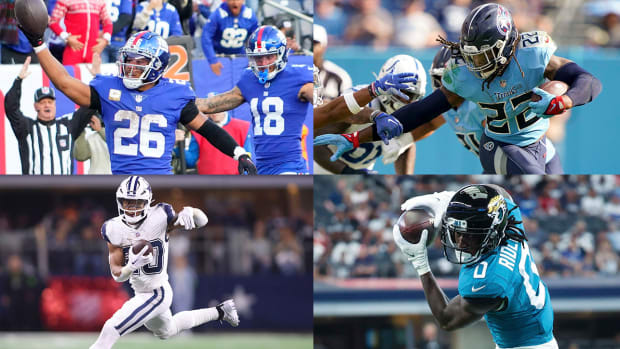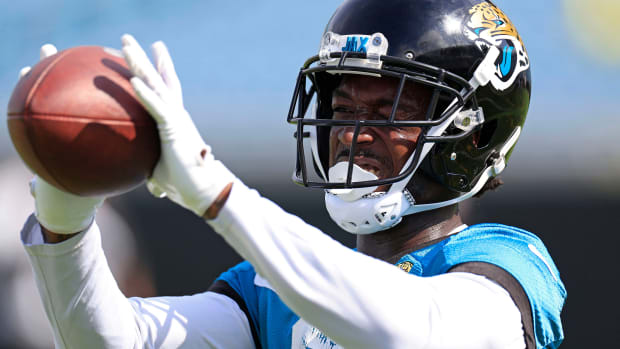2021 Fantasy Baseball: Introduction to SIscores
The development of SIscore started with the theory around Average Player Scores. It is challenging to determine a baseball player's value in the fantasy baseball market when drafting when you have multiple positions, never mind numerous scoring categories. The average player theory is a way to compare a player’s value for overall impact in team-building in 5-by-5 roto formats and within the spectrum of each position or category.
Once we have a baseline of the average player, we can determine which players have the most significant edge. After establishing these scores at each position, the next step is then comparing the best option at other positions.
Each season, the player pool changes in the fantasy baseball world. Some positions will have more depth, and others will only have a couple of reliable options. When a fantasy owner is preparing to do his draft prep, he wants to find each position's hidden values. By doing this, he can select the most potent options at the other positions early in the draft.
Sports Illustrated has developed a way to determine each player’s value with each category relevant to their production. Hitters have five offensive categories (batting average, runs, home runs, RBIs and stolen bases). Pitchers also have five categories (wins, ERA, WHIP, strikeouts and saves).
With these scores, a fantasy owner can quickly look at stats to see which players have the most value either by last year’s stats or this year’s projections from any source. When using projections, a fantasy owner’s success will only be as strong as his/her ability to interpret information. Finding the best source for that information is essential.
Our SIscore is built for 12-team, 5-by-5 Roto leagues with once-a-week pitching moves. In the future, we could modify the options for 10-team and 15-team leagues, and we may even add bi-weekly pitching move leagues.
The most challenging part for any fantasy owner to understand is draft rankings or cheat sheets due to the underlying information behind each player's profile. At any position in baseball, I may only like a handful of players. When I rank them, I can't leave players I don't like off the cheat sheet, and it wouldn't be fair to list them poorly just based on my opinion.
Here’s a look at the midpoint values in 2019 (I decided not to use the data from last season due to the sample size being too small) in a field of 2,112 teams in all 10 categories:
Hitters
- BA: .265
- R: 1125
- HR: 348
- RBI: 1083
- SB: 114
Pitchers
- W: 86
- SV: 66
- ERA: 3.998
- WHIP: 1.230
- K: 1,415
Fantasy owners use ADPs (average draft position) to better prepare for the upcoming draft season. ADPs give fantasy owners a feel for a player's value in the open market. It is a great tool, but a fantasy owner must understand the value of the information.
ADPs from mock drafts have less merit as a full roster of owners doesn't complete many drafts, and many drafters may lose interest at some point during the draft. The best information in fantasy baseball comes from owners playing for real money or owners competing in a real league played out during the season.
Our SIscore can work with any projections to deliver results. We researched all 30 baseball teams. We then do our team profiles for each team's projections. With this information, we provide Sports Illustrated rankings based on the SIscores. Also, we can back-check the results from the previous season to see how each player stacked up against their competition.
At the same time, we can deliver weekly rankings based on playing time and opportunity. We break the season into 26 weeks to come up with the weekly results. If a player is projected to play in seven games, he’ll have a better chance to produce stats in the counting categories. More playing time doesn’t necessarily mean he’ll have a higher score than a player with a much higher skill set with five games.
Note: Each season, SIscore equations are adjusted for the current playing field in major league baseball. If home runs are declining, a big power hitter will be rewarded for his edge in home runs. If steals are scarce, an elite base stealer will have plus value in the stolen base category.
Once we have each player's projections matched up with the SIscore, we have a way to compare all players' values. For this information to have the most success, we need to compare players at like positions.
In 2021, Ronald Acuña, Fernando Tatis, Juan Soto, and Mookie Betts offer five-tool skill sets that should be an edge over almost every other player in drafts. The question comes down to how much of an advantage when pairing with another player later in the draft.
If I selected Fernando Tatis at shortstop and paired him with outfield Kyle Tucker this draft season, would that combination be worth more than Acuña and Bo Bichette (12-team format)?
The above stats are from my early projections for Tatis and Seager. They have a combined SIscore of 19.91 while an excellent combination of power (72 home runs) and speed (63). (Remember, these are projections, which are subject to different opinions).
Acuña and Bichette project better in runs and batting average while having a much weaker SI rating in runs batted in (158 to 211). The difference in SIscore (17.99 to 19.91) can be overcome with more playing time or better production than expected.
Both combinations grade well while having a reasonably high probability of being executed in 12-team leagues. I would grade them as almost a dead heat, but both teams will need to figure out a plan on the pitching side.
The top three pitchers drafted in 2021 all project highly in SIscore. The trick this draft season is deciding between a foundation ace and a five-tool player at the front of drafts.
Cole paired many late second-round bats would deliver a similar SIscore as the Tatis/Tucker and Acuña/Bichette teams, but the team build would be on a different path.
The next pieces added to each team plan will vary from owner to owner and hinge on draft flow.
ADPs and a player's draft value help a fantasy owner make trade-off decisions within drafts. Once fantasy owners have this information, they must decide how much they trust or agree with a player’s projections. He then should compare that player with other players at the same position in the projected ADPs.
The bottom line here is that a fantasy owner is trying to gain an edge with each of his first few picks in the draft while filling as many categories as possible. Each decision takes a fantasy owner in a different direction.
We also had access to multiple other events with large amounts of teams competing for an overall championship. The information we used is from a league with once-a-week transactions for pitching.
The midpoint for wins in 2019 was 86, which was divided into nine pitching slots to come up with 9.555 wins per pitcher. I then used the overall standing from a league with 2,112 teams to determine the points gained for a win or lack of a win. I used +/- 500 spots in the standing to get a range of points gained or lost from the midpoint of wins. It was amazing to see 1,065 teams fall between 78 and 94 wins. I divided 1000 overall points by 16 wins to come up with 62.5 overall points for each win. There were 147 leagues in this competition, so each win within a single league environment was worth .35511 league points.
For the ERA and WHIP category, I researched a few leagues that I had the final results. I determined that a competitive team would need about 1,350 innings throughout the year. I then found the medium ERA (3.998) and whip (1.230) in this 12-team format in 2019. I then subtracted the innings pitching by the pitcher from 1350. I multiplied that number times (.44422 = 3.998/9). This data gave me the total number of runs allowed for the remaining innings for the medium ERA by inning. I then added the total number of runs allowed by each starting pitcher, and I divided that number by 1,350 innings. This result delivered the +/- impact of each pitcher based on the number of innings pitched or projected to pitch. The range was 1,000 league points divided by a gap of .382 in ERA. This number was then divided by 176 leagues. I used a -14.874 data point to show a lower ERA awarded more points.
I repeat this same process for WHIP. The range was 1,000, divided by .076 (gap in WHIP from 1.192 to 1.268). I then divided it into 176 leagues to deliver -74.761. Again, I used a negative number as a lower WHIP is the desired result.
For strikeouts, the medium total was 1,415 strikeouts. Pitchers aren’t created equal in Roto formats, but I still need to divide 1,415 by nine pitching spots. The average sum of strikeouts per starter came to 157.222. The range of strikeouts for 1,000 teams came to 171 with a low of 1,326 at the 1,557th position and 1,497 at the 557th position. Each strikeout was worth 0.033227 points in the standing after dividing by 176 leagues.
This midpoint for saves was 66 in this event. A fantasy owner typically will get saves from two to three roster spots in their starting lineup, but we need to base the target goal on nine pitchers leading to a negative score for each starting pitcher in saves. Over 1,000 spots in the standings in a 2,112 team league, there was a difference of 28 saves. This total came to 0.202922 points in a single league per save. Many Fantasy owners play the save category differently, creating a wide range of results. A format with an overall prize does lead to more teams competing in this category.
For batting average, I used the same theory for ERA and WHIP. I determined by looking at all 2,112 teams that I needed 7,350 at-bats to be at the midpoint. The midpoint for batting average was .265 in 2019. For each player, I subtract their at-bats from 7,350 then multiplied that number by .265 to give the total number of hits to deliver a medium batting average. I then added the player's total hits to this number, and I divided that total by 7,350 at-bats. These results gave me the impact of each player as far as +/- in batting average. The range of 1,000 spots in the standing was 0.0089 points in batting average or about 64 hits over 7,350 at-bats. So, 1,000 divided by .00879 divided by 176 leagues = 638.407 points for batting average.
The midpoint for runs was 1,125. The range was 116 runs over 1,000 spots in the standings, which delivered 0.048981 points per run in a single league.
The medium point for home runs was 348. The gap between 557th place and 1557th place in a 2,112-team format was 47 home runs or 0.12089 points per home run in a single league.
The midpoint for RBI was 1083. The difference in 1,000 points in the overall standing in RBI was 107 RBI. This number worked out to .053101 points per RBI in a single league.
A team needs to get 114 stolen bases to finish at the medium point last season. The gap between 500 spots in the overall standing in either direction was 32 stolen bases leading to each steal being worth 0.210438 points in roto formats.
Using these totals, a fantasy owner can easily see which players had the most value last season. It is a tool that will help you when you are making future decisions. The real trick is to create these values for this year’s projections. By understanding the player pool and each player’s value within each category, a fantasy owner can make better draft decisions. Here’s a look at the chart for both batters and pitchers to show power points gained or lost in each category within a league environment in 2019 (again, I'm not using 2020 data due to a small sample size):
To add some food for thought about values in each category, each one of these category points is worth three points gained in a league environment >>> .330 BA, 140 runs, 50 home runs, 135 RBI, and 25 stolen bases on the hitting side. Pitchers would need about 18 wins, 23 saves, 2.25 ERA, 0.85 WHIP, and 250 strikeouts to gain about three points in each category's standing.
On the downside, a batter would have to hit .210 to cost a team two points in the standings along 40 runs, eight home runs, 40 RBI, and no steals. A pitcher would need to get five wins, no saves, 5.00 ERA, 1.41 WHIP, and 110 strikeouts to cost his team 1.5 points in each category's standing.









































